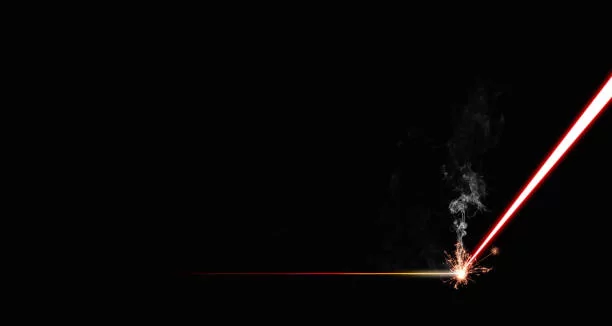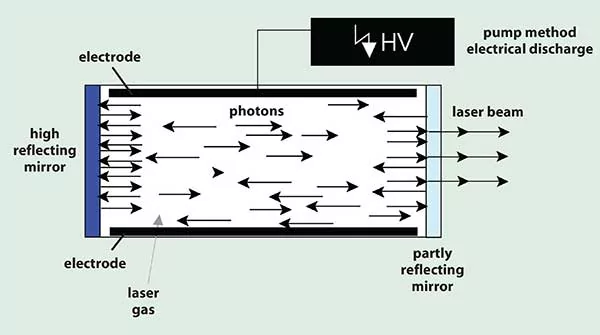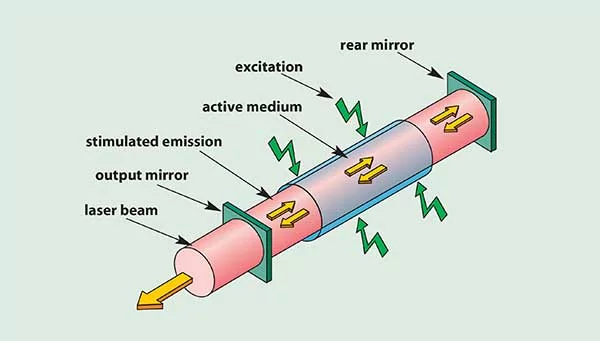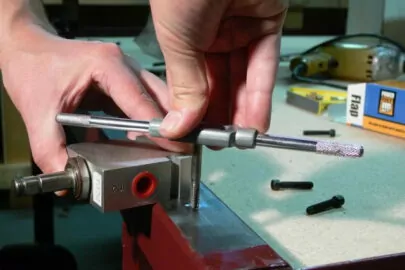Laser technology has experienced significant growth since the invention of the first set of lasers about fifty years ago. There has been a significant increase in power and improvements in beam quality. Lasers have become essential, allowing advancements in various industries, from medical to communication.
Lasers are machines that stimulate the emission of photons from excited atoms or molecules, producing a strong beam of coherent monochromatic light (or other electromagnetic radiation). In addition to being used in surgery, drilling, alignment, and guidance, lasers are used in holography, barcode reading, and the recording and playback of compact discs.
This distinctive article provides a detailed description of the types of lasers available. It consists of an overview of the main categories in the wide range of technologies created to create coherent, collimated light beams, which can be found below. Variations have been created for these categories, some of which are potentially significant technologies.
What Is a Laser?

Laser, also known as “Light Amplification by Stimulated Emission of Radiation,” is a device that can produce coherent, monochromatic light using stimulated emission. These unique qualities set these particular light sources apart from conventional light sources. The idea behind stimulated emission is to give molecules or atoms energy so they will release photons, which are tiny particles that carry light. Coherence, which ensures that the light waves emitted have a constant phase relationship, is one of the critical characteristics of laser light. Unlike incoherent light sources such as incandescent bulbs, laser light is highly focused and powerful.
The ability of lasers to emit a single wavelength or color of light—a property known as monochromaticity—is another essential feature. Lasers can intensify light due to the stimulated emission of a solid, liquid, or gas known as the gain medium located inside the laser. The gain medium’s characteristics dictate the laser’s wavelength. Amplification is aided by the reflection and refraction of light through the gain medium by mirrors located inside the optical cavity of a laser. As one mirror has a high reflection and the other is partially transparent, the laser beam can pass through it.
External energy sources like electrical current, light, or another laser are needed to excite the gain medium and start stimulated emission. Numerous fields use lasers, including telecommunications, healthcare, industry, research, and entertainment. They are used in everything from industrial processes like cutting and welding to precise measurements, communication systems, and medical procedures. Due to their special qualities and adaptability, lasers are now essential instruments in many industrial, scientific, and daily applications.
10 Common Types of Lasers

There are several types of lasers available for different uses. Here are some of the most common lasers you’ll find:
Gas Lasers
They are also known as CO2 lasers. In gas lasers, population inversion is usually accomplished by passing a voltage through a glass or ceramic tube that houses the low-pressure gas or gas mixture that serves as the gain medium. The voltage induces An electric current in the tube, which creates an electric field there. As a result of their collisions with the gas atoms, these electrons excite them to energies greater than what will be the upper laser level.
The population of the two laser levels is inverted because the lower laser level usually decays to the ground state much faster than the upper level. The resulting laser transitions operate at well-defined wavelengths and have very narrow spectral bandwidths due to the highly diluted radiating species.
Fiber Lasers
A fiber laser is created by integrating a resonator and fabricating a solid-state gain medium into an optical fiber. Because of the special light-guiding characteristics of fibers, such as their strong spatial confinement over long distances, this class of lasers is typically handled differently from the “bulk” solid-state lasers covered above. A fiber laser is distinguished from other lasers or gains media that are only coupled to optical fibers by having the optical fiber act as the gain medium in and of itself.
Usually, the glass host material that makes up the optical fiber’s core is doped with laser-active ions. The rare-earth elements Yb, Er, and Tm are the most frequently occurring dopant ions.
Pulsed Lasers
Instead of being classified as a technology, pulsed lasers are an operational mode. This class includes any laser that can produce brief, powerful pulses instead of a continuous beam. These lasers produce precise temporal control high-energy light bursts. Several pulsed laser applications include research, materials processing, spectroscopy, imaging, medical, and defense. Having strong and well-synchronized light bursts enables multiple fields.
Pulses can last for many longer periods or just a few femtoseconds. This depends on the laser technology, the excitation techniques, and the application’s needs. Short pulses enable intricate applications in spectroscopy, atomic-level manipulation, and material analysis.
Dye Lasers
The active medium in dye lasers is made up of organic dye solutions. In the visible and near-infrared range, they provide excellent tunability. Dye lasers can produce high-energy, short-duration pulses. When a dye laser is excited by a standard xenon discharge tube, bright light flashes are produced. This is perfect for photochemistry, laser-induced breakdown spectroscopy, and time-resolved spectroscopy.
They can be efficiently wavelength-tuned over a broad range of frequencies by adjusting the dye solution or the optical amplification cavity. A wide range of radiation, from ultraviolet to near-infrared (NIR) wavelengths, is produced as a result. Dyes molecules can produce ultrashort pulses with durations of femtoseconds or picoseconds, thanks to their large gain bandwidth. They are useful for research and medical applications because of their precise energy control.
Free Electron Lasers (FELs)
Using a magnetic field, FELs produce stimulated emission by manipulating a high-energy electron beam. The free electrons come from a linear accelerator, and their radiation wavelength depends on their energy level. Because the electron energy levels are precisely controlled, FELs can cover a wide range of wavelengths, from the infrared to the X-ray region. FELs are adaptable for a variety of applications due to their broad tunability. They increase the radiation through a process known as self-amplified spontaneous emission (SASE). Electrons produce radiation when exposed to an oscillating magnetic field—amplification results from this, encouraging more emission.
Solid-State Lasers
A laser that uses active ion species introduced as impurities in an optically transparent host material, typically crystals or glasses, is called a solid-state laser. Strong and spectrally narrow transition cross-sections, strong absorption bands for pumping, and a long-lived metastable state are characteristics of materials for laser operation that are covered in Light-Matter Interactions in Lasers and Required Components for Lasing. These features are typically found in ions that have optical transitions between states of inner, incomplete electron shells.
To maintain these desired qualities, these ions must be shielded from other ions or protected from them. This is achieved by encapsulating the ions in a solid host material whose lattice permits ion doping levels adequate for a gain medium while protecting the ions simultaneously.
Neodymium Lasers (Nd)
Nd lasers, which use neodymium-doped crystalline materials as the active medium, are a subclass of the solid-state laser family. By altering the host crystal, neodymium lasers can produce a range of spectra. The majority of Nd lasers emit 1.064 µm (IR). A parametric oscillator or frequency doubler can be used to retune the beam to ultraviolet, blue, and green radiation. They are perfect for laser cutting, welding, and marking applications because they efficiently deliver high-energy radiation. Nd lasers can be used in pulsed or continuous wave mode.
Applications requiring precise temporal control, like range finding, laser ablation, and laser-induced breakdown spectroscopy, are best suited for continuous wave (CW) operation. On the other hand, pulsed Nd lasers are employed in these applications.
Excimer Lasers
Excimer lasers are one instance of a subclassification that developed into a stand-alone classification. Although they are a type of gas laser, they are not like other gas lasers in some crucial ways, and they have qualities that make them ideal for various applications. Their unusual and practical feature is their ability to deliver ultraviolet (UV) emission at a relatively low cost. Excitation wavelengths of 193 nm (argon fluoride, ArF), 248 nm (krypton fluoride, KrF), and 308 nm (xenon chloride, XeCl) are a few examples of excimer lasers.
Excimer lasers are limited to pulsed operation, with brief high-peak power pulses. This qualifies applications involving precise material ablation and micro-material processing.
Chemical Lasers
A chemical reaction excitation source powers chemical lasers, which produce laser light. When two or more starting chemicals react violently, the population inversion (of excited electrons) is produced, stimulating emission at very high outputs. Compact sources can produce high output, frequently in the megawatt range.
Because of their intensity, chemical lasers are helpful for laser-induced plasma, high-energy physics, and military systems. Both CW and pulsed modes of operation are available. Applications for pulse-mode chemical lasers in the military and defense sector include laser-based missile defense systems and directed-energy weapons.
Metal-Vapor Lasers
Excitation of metal vapor serves as the active medium in metal-vapor lasers, which produce laser light. They work by raising the energy levels of metal atoms or ions, which cause them to undergo stimulated emission and release coherent laser light. One of metal-vapor lasers’ special and practical characteristics is their extreme UV emission capabilities. The active medium in these lasers is vaporized metal. Mercury, copper, gold, and silver are frequently utilized metals. Using a different laser, a metal sample is usually heated to the temperature at which it vaporizes to produce the metal vapor. Depending on the metal used, they emit mainly in the visible and UV spectra. Copper vapor lasers emit green light at approximately 510 nm, and gold vapor lasers emit yellow light at roughly 628 nm.
Semiconductor Lasers (Diode Lasers)

emiconductor lasers are commonly referred to as laser diodes because they function similarly to a diode, with current flowing inside the junction’s forward path. By introducing rate carriers into the area bounded by the intersection, recombination radiation is generated. Stimulated emission will manifest and a population inversion can be carried out, provided that the modern injection is strong enough.
The massive refractive index differential between the air and the semiconductor cloth provides the crystal surface with sufficient reflectivity for the crystal to function as a self-contained resonator cavity. Due to advancements in semiconductor manufacturing techniques and the incorporation of electrical pumping and compact laser design, laser diodes have surpassed other types of lasers in terms of energy and performance, compact length, and compatibility with electronic components.
Which Kind of Laser Is Used for the Laser Cutting Process?
The kind of laser used commonly for the laser cutting processes is the CO2 laser. Because of their distinct characteristics and abilities, CO2 lasers are extremely effective for cutting a wide variety of materials. This laser range was chosen for its distinct characteristics and competencies, making it particularly effective in slicing a wide range of substances. CO2 lasers typically have a wavelength of 10.6 micrometres, which places them in the far-infrared range. This wavelength is ideal for cutting through metals, plastics, wood, and clothing materials.
How to Select the Right Laser Types for Your Needs

Go through this section before choosing any laser for your need to know the most suitable:
Material Compatibility
Different lasers are perfect for decreasing or engraving unique materials. For instance, CO2 lasers are versatile and appropriate for herbal materials like wood and acrylic, at the same time as fiber lasers are greater powerful for metals. Consider the materials you will be operating with and pick out a laser kind that aligns with their features.
Thickness of Materials
The thickness of the materials you need to produce plays a critical role in deciding on an appropriate laser. Some lasers excel at cutting through thick materials, while others are higher, best for thin sheets. Ensure the laser’s power and ability to form the thickness of the substances you intend to use.
Precision Requirements
If your material requires excessive precision and complex data, pick a laser type acknowledged for its accuracy. CO2 lasers, for instance, are renowned for their precision in engraving, at the same time as fiber lasers are preferred for their pleasant reducing competencies.
Speed of Cutting
Consider the favored reducing pace of your software. Some lasers are optimized for instant reducing, making them appropriate for excessive production environments, even as others prioritize precision over speed.
Application Specifics
Tailor your laser desire to the specifics of your utility. Different laser types also have unique functions that motive them to be more suitable for certain duties, together with marking, welding, or floor treatment.
Budget Constraints
Evaluate your budget constraints and pick a laser type that aligns with your monetary concerns. While specific lasers may have a better preliminary price, they could provide higher efficiency and price effectiveness.
Safety and Compliance
Ensure that the selected laser type complies with protection requirements and guidelines. Consider protection features, which include enclosures and interlocks, to protect operators from ability hazards related to laser operations.
Environmental Considerations
Assess environmental factors, like ventilation requirements and waste control. Some laser procedures may also produce fumes or by-merchandise that require the right dealing to satisfy environmental regulations.
Applications of Different Laser Types

These are the various applications of the different laser types:
- Industrial Applications: CO2 and fiber lasers are generally used for commercial reducing and staining programs. Nd: YAG lasers have been discovered to be used in welding and floor treatment.
- Medical Applications: CO2 lasers are applied in surgical strategies, even as diode lasers locate programs in medical imaging and diagnostics.
- Electronics and Electrical Applications: Fiber lasers are preferred for cutting and marking in electronics production. UV lasers are used for microelectronics and semiconductor processing.
- Aerospace Applications: Fiber lasers are appropriate for precision cutting in rapid prototyping aerospace components, and Nd: YAG lasers find applications in welding and drilling.
- Automotive Applications: CO2 lasers are used for cutting and engraving in car part manufacturing, and diode lasers are used in welding and soldering.
Conclusion
This article described the various types of lasers, explained each, and reviewed the factors to consider before choosing any laser for your needs. It also explained the various applications of lasers in different fields. Do you wish to know more about lasers or have any laser-related needs? Contact Zintilon today. All of your production and prototyping needs can be met by Zintilon’s extensive manufacturing capabilities, including sheet metal fabrication, laser cutting, and other value-added services. Get a quote now for more information!




